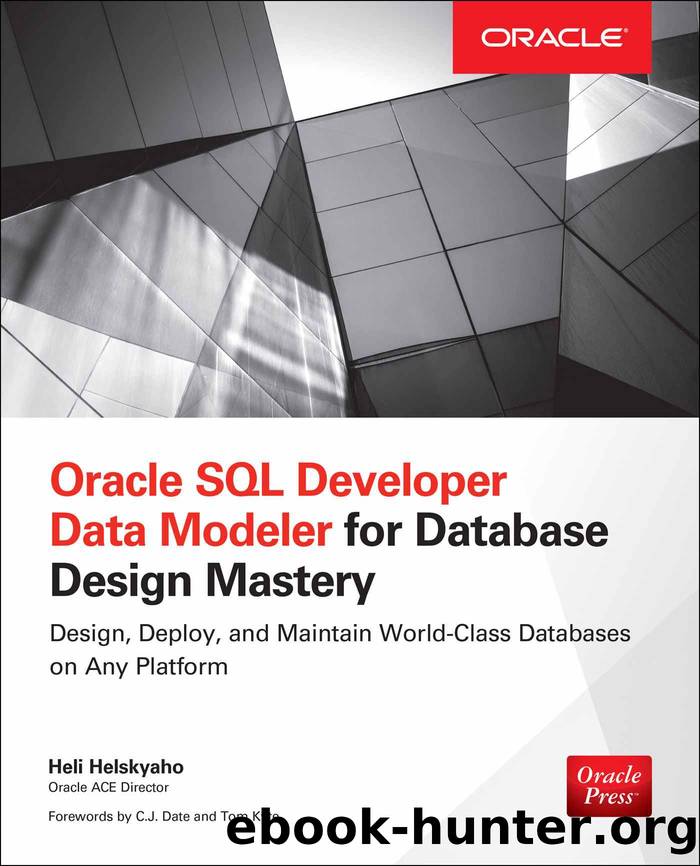Oracle SQL Developer Data Modeler for Database Design Mastery (Oracle Press) by Heli Helskyaho

Author:Heli Helskyaho [Helskyaho, Heli]
Language: eng
Format: azw3
Publisher: McGraw-Hill Education
Published: 2015-05-17T16:00:00+00:00
NOTE
If you change a logical property of a column in the relational model (data type, length, and so on), you can see the change in the physical model immediately.
On the Column Not Null Constraints tab, you can change the parameters for a possible Not Null constraint for this column or create a new one if there is no constraint. First you define the name for the constraint: Initially (Immediate, Deferred), Deferrable (yes/no), Enable (yes/no), Validate (yes/no). Then you select a table name from a list as an exceptions table. On the Column Check Options tab, you can change the parameters for a possible check constraint for this column: Initially (Immediate, Deferred), Deferrable (yes/no), Enable (yes/no), or Validate (yes/no); then select a table name from the list as an exceptions table. If the column is an auto-increment column, you can define the parameters on the Auto Increment tab. Data Modeler also supports the native identity column in Oracle 12c.
You can also specify special parameters for XML types, nested table collections, and Varray collections on these tabs: XMLType Options, XMLType Storage, Varray, and Nested Table. You can see and edit the Comments and Comments In RDBMS fields on the Comments tab, but remember that if you change them in the physical model, then changes in the logical model (for these comments) will not be shown in the physical model anymore.
Download
This site does not store any files on its server. We only index and link to content provided by other sites. Please contact the content providers to delete copyright contents if any and email us, we'll remove relevant links or contents immediately.
| Access | Data Mining |
| Data Modeling & Design | Data Processing |
| Data Warehousing | MySQL |
| Oracle | Other Databases |
| Relational Databases | SQL |
Algorithms of the Intelligent Web by Haralambos Marmanis;Dmitry Babenko(16234)
Azure Data and AI Architect Handbook by Olivier Mertens & Breght Van Baelen(7674)
Building Statistical Models in Python by Huy Hoang Nguyen & Paul N Adams & Stuart J Miller(7655)
Serverless Machine Learning with Amazon Redshift ML by Debu Panda & Phil Bates & Bhanu Pittampally & Sumeet Joshi(7529)
Driving Data Quality with Data Contracts by Andrew Jones(7292)
Data Wrangling on AWS by Navnit Shukla | Sankar M | Sam Palani(7290)
Machine Learning Model Serving Patterns and Best Practices by Md Johirul Islam(7029)
Learning SQL by Alan Beaulieu(6237)
Weapons of Math Destruction by Cathy O'Neil(6214)
Big Data Analysis with Python by Ivan Marin(5933)
Data Engineering with dbt by Roberto Zagni(4930)
Solidity Programming Essentials by Ritesh Modi(4565)
Time Series Analysis with Python Cookbook by Tarek A. Atwan(4399)
Pandas Cookbook by Theodore Petrou(4086)
Blockchain Basics by Daniel Drescher(3540)
Natural Language Processing with Java Cookbook by Richard M. Reese(3143)
Hands-On Machine Learning for Algorithmic Trading by Stefan Jansen(3042)
Learn T-SQL Querying by Pam Lahoud & Pedro Lopes(2929)
Feature Store for Machine Learning by Jayanth Kumar M J(2925)
